ENERGY IN THE DEVELOPING WORLD
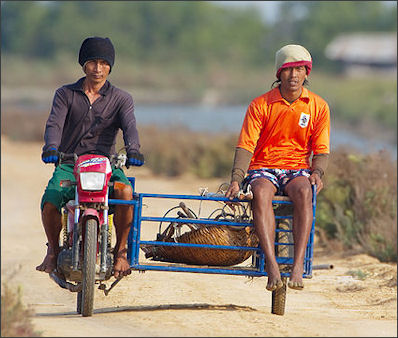
Salt Farmers on a motorbike in Pakistan Americans on average use a 1,000 times more energy per person than villagers in the developing world. An estimated 1.5 billion people worldwide have no electricity.
In the developing world electricity and fuel shortages are major obstacle to economic growth, creating jobs and having a reasonably comfortable life. One of the primary aims of many poor countries is to ensure there are adequate energy supplies. This goal often involves building power plants and dams — aims that often run counter to the goals of environmentalist and those combating global warming.
Many parts of the developing world that have electricity often experience power shortages. Many entrepreneurs and household rely on diesel generators or car batteries to supply power when the power is off. Schools often close early and hospitals turn away patients because there isn’t enough power.
Energy shortages are caused by poor planing and booming industrialization and, often, a lack of rain that affects rivers that feed hydropower dams. If people that don’t have access to electricity suddenly get it, there are worries about the increased burning of fossil fuels such as coal, and oil to produce it and increases in air pollution and global warming.
Energy Sources in the Developing World
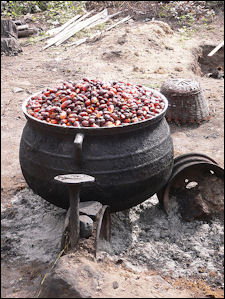
Palm oil production
in Jukwa Village Ghana Places with little or no electricity rely on generators, candles, kerosene lamps, paraffin lanterns, firewood, batteries or car or tractor batteries. The nights in these places are very dark. You can see the stars clearly from almost anywhere because there are few lights.
Many rely on kerosene lamps as their primary source of light and cooking fuel. Kerosene is highly flammable and emits greenhouse gases. Fumes are smelly and noxious. Every year thousands of people die in fires and accident involving kerosene stoves and lamps.
For many people dung, firewood or charcoal are the main sources of energy. The poorest people use dung and agriculture waste fires. People slightly better off use wood or charcoal and those better off still have access to propane and kerosene. Those lucky enough to have electricity usually only receive it for a couple of hours in the evening or endure frequent brown-outs and power outages Gasoline is sometimes in such short supply and so expensive that is sold in small bottles.
Governments often offer subsidies and have price regulations to keep fuel prices artificially low. State-owned refineries sell at a loss or use taxpayer funds to buy imported oil. If they didn’t there is a risk of riots or revolts.
Fires, Dung and Trees
In most homes cooking is done on a metal plate placed over a wood or dung fire. Cooking is often done outside because there is a danger of fire. Kerosene, propane, oil and butter lamps are used to light a house. Candles are regarded by many as prohibitively expensive.
People who rely on cow dung for energy, collect it in the morning from their corrals or fields. Some of the dung is mixed with straw and made into a past that is used to plaster house walls. Most of the rest is flattened and broken into pieces and used as fuel. Collecting and processing dung occupies much of the time of the children and women.
Trees cut down in deforested areas are often used for fuel or charcoal. Fuel wood consumption in the developing world increased 35 percent between 1975 and 1986.
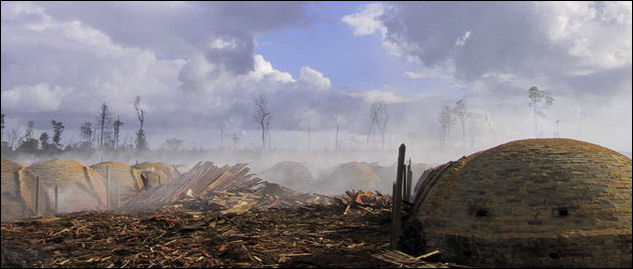
Deforestation and charcoal making
Charcoal
Charcoal is the porous, black brittle substance produced when woods or bones are partially burned. It is an impure variety of carbon, which is able to absorb large quantities of gases. Charcoal production and use creates greenhouse gases.
Charcoal is preferred to wood because it is slow burning, produces little ash, gives off relatively little smoke, produces a hot even heat ideal for cooking, and is easy to transport.
Industrial charcoal is used in making gunpowder, filtering water, curing tobacco, manufacturing glass, making silicon alloys and chrome steel. In the developing world it is mainly used for cooking and as a source of heat.
Charcoal is made by slowly burning hardwoods for three days under a blanket of wet leaves and earth. It is a dirty process. Using the traditional method, wood is placed in a pit in a pyramid-like pile and covered by the earth-leaves blanket. Holes are left at the bottom for air to enter and at the top for a chimney.
The wood burns slowly. When fully burned, the heap is covered and left to cool for two or three days. Using this method the weight of the charcoal is about 20 percent of the wood used to make it. These days charcoal is often made in special ovens. With this method the weight of the charcoal is about 30 percent of the wood used to make it.
Fires and Health
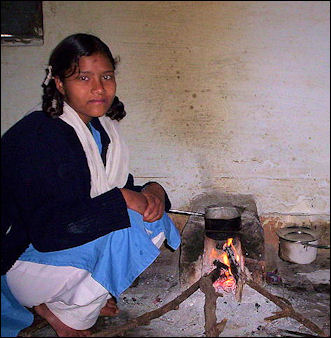
Indian girl making tea over open fire Many people suffer from respiratory illnesses caused by inhaling smoke from cooking and heating fires in huts with virtually no ventilation. Health experts estimate that 4 million children die worldwide from smoke-related respiratory.
The illnesses are caused by inhaling carbon monoxide and particles of soot and ash — made with dung, agricultural waste and/or wood — everyday for years. Children's lungs are more sensitive than the lungs of adults.
NGO workers say that one solution to this problem is to ferment the dung into methane "biogas," which is a clean fuel.
Alternative Energy in the Developing World
People are looking more and more to alternative energy sources to supply energy to villages. Solar converters can provide energy for lowed-powered machines like radios, light bulbs and televisions but don’t provide enough power to run refrigerators. A single waterwheel can supply enough energy to light homes and run appliances in an entire village.
Some environmentalists see the developing world as virgin territory to take the lead in developing renewable energy technologies such as wind and solar energy, leap-frogging western models that rely on oil and coal. Many economist see this view as unrealistic and dangerous to the countries that chose that path. The Indian entrepreneur and author William Bissel told the Washington Post, “The United States and Europe have had the energy they needed to grow and develop. But we haven’t had our had or 21st century yet.”
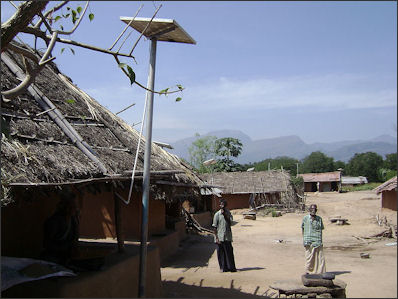
village solar unit Micro-financing bodies are playing a key role in setting up alternative energy sources in villages. Praddep Dadhich of the energy research institute TERU told Reuters, “They are reaching people who otherwise have limited or no access to electricity and depend on kerosene, diesel or firewood for their energy needs...The applications not only satisfy these needs, they also improve the quality of life and reduce the carbon footprint.”
There are solar collectors that can be used for cooking. In the desert sun such a devise can boil water in three minutes. There are also solar powered lanterns and fuel-efficient ceramic stoves. Biogas installations convert animal waster into methane.
Jatropha, a plant native to Central and South America, is being raised in Africa and Southeast Asia as a biofuel source. Jatropha is a deciduous tree that grows to a height of three meters. Fuel is made from oil squeezed from its poisonous plum-size fruit. The plant is very durable and can be raised on arid lands and depleted soils.
About a quarter of developing world food production is lost to spoilage, . "Pot-in-pot" refrigerators devised by Nigerian teacher Mohammed Bah Abba have helped farmers to keep their produce from rotting in hot areas. The device consists of one pot placed in another. Between the pots is wet sand. When water evaporates it cools produce placed inside the inner pot.
The BayGen Power company in Cape Town South Africa produces a six-pound, low-fidelity, hand-cranked radio that sells for $40. Invented by British inventor Trevor Bayliss, it utilizes a spring (similar to the one used to role up seat belts) that is tightened with a hand crank and powers a generator when uncoiled. Useful in places where there is no electricity and batteries are prohibitively expensive, it operates for about 30 minutes on 20 seconds of hand cranking. The BayGen Power company also makes a hand-powered flashlight. Sony makes a waterproof radio powered by a hand crank generator. It is marketed as being useful in natural disaster and sells for $103.
Low-Tech Stoves
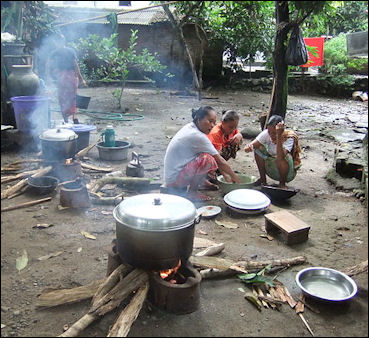
women cooking in Lombok, Indonesia Solar grills use mirrors to focus sunlight on the grill tray. The Hot Pot is a device with aluminum panels and a glass bowl that can heat food to 300 degrees F with solar energy. It sells for about $100. Solar Household subsidizes a $40 Hot Pot with cardboard reflectors. The United Nations Development Programme has given people $110 to build a solar oven from wood.
In 2009, John Bohmer, a Norwegian living in Kenya, won a $75,000 “green” prize for devising a $7 version of cardboard box oven than can disinfect water and cook food. The outside is comprised of a large box with aluminum-foil-covered flaps that can be tilted to collect heat. Another box sits inside the outside box. The inside of this box is painted black to absorb heart. Between the two boxes are newspaper, grass or sawdust that acts as insolation. A dark pot with a lid is placed in the black box. A glass or Plexiglas lid helps keep heat in. Such a devise can generate heat of 195 degrees F on June day in Washington D.C.”more than enough the kill germs in water.
Japanese organization called Soft Energy Project is involve in getting low-tech stoves to places that have been heavily deforested by people seeking firewood.
Chinese Solar Water Heaters
China is a leader in the manufacturing and sale of solar water heaters — relatively unsophisticated, mattress-size, stainless steel devices that use the sun rays to heat water and cost about $220. Used for household purposes such as showering. washing dishes and washing, the device consists of an angled row of cola-colored glass tubes that absorb heat from the sun. The most common models are filled with cold water. As the solar heater is heated, the water rises into an insulated tank where it can remain hot for days. [Source: David Pierson, Los Angeles Times, September 2009]
Models produced by Dezhou-based China Himi Solar Energy Group cost between $190 and $2,250 and work even when temperatures are below zero and the skies are filled with clouds or smog. Unlike solar panels that use expensive technology to produce electricity the solar water heaters consist of a row of sunlight-capturing glass pipes angled below an insulated water tank. Sunlight travels freely through the glass, generating heat that is trapped in a central pipe where the heat is transmitted to water. The secret to operating in cold temperature is the vacuum separating the inner tube with its energy-trapping coating from an outer tube.
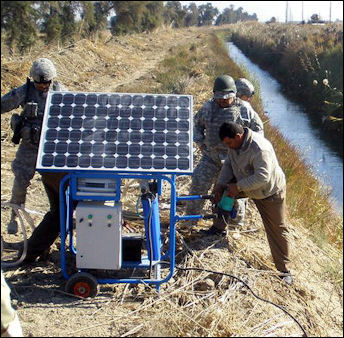
Solar-powered clean water project in Iraq In Rizhao, a seaside city in Shandong Province with 2.8 million people, 99 percent of the households use solar water heaters. The devices used there have improved so much over the years some don’t need direct sunlight and function on cloudy or smoggy days. Advanced models have electrical water heaters that switch on during frigid cold days.
As of 2009 more than 30 million homes in China had solar water heaters, accounting for two thirds of the world’s solar water heating energy and preventing more than 20 million tons of carbon dioxide from entering the atmosphere. Christopher Flavin of the Washington-based Worldwatch Institute told the Los Angeles Times, “China absolutely dominates the global market and they have done it relatively quietly and without a lot of fanfare. It’s an interesting example of their ability to take technology that was developed elsewhere and adapt it to their market on a scale no one had conceived of.”
The heating of water typically accounts for a quarter of the energy used in a building. The use of water heaters is so high in Rizhao because the local government there requires solar water heaters to be installed in all homes and subsidizes their cost. For many families that installed the devices it was the first time they ever had reliable hot water. In Dezhou, another city known for energy conservation, 90 percent of the household and streets are lit with solar-powered lights.
The solar water heater market in China is very competitive. More than 5,000 companies manufacture water heaters there. The president of Gold Giant, one of 150 manufacturers in Rishao, told the Los Angeles Times, “The market is huge but the competition is fearsome.” Another water heater maker has had success with the slogan that his water heater will “take the feathers off a chicken.” The largest in China, Himin Solar Energy Group, got a $50 million investment from Goldman Sachs. Some are looking for export market abroad. The American market, where people use an average of 400 liters of water daily, will be difficult to crack because the heaters don’t heat that much water.
LED Lamps and Solar Lanterns
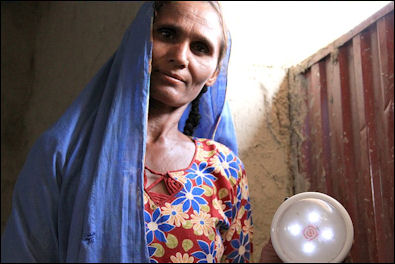
Lighting in Sindh Pakistan Some people have no light sources and simply go to bed or sit around in the dark when the sun goes down, Others use oil lamps or candles. Oil lamps generally only illuminate an area of 50 centimeters around the light and give off fumes that can lead to bronchitis.
Low-energy, white light-emitting diodes (LED) lamps hold great promise for lighting up villages. Enough lamps to light up a whole village use less energy are needed to light up a single 100-watt bulb. NGOs are helping local entrepreneurs to sell the lights so they are the ones make money not outsiders. Villagers who have the lights no longer have to spend lots of money on kerosene and batteries.
A Japanese organization called the Gaia Initiative is active in introducing solar lanterns to villages without electricity. The lanterns can be recharged using power generated by solar panels. The system, which includes a 1.6-square -meter solar panel and 50 lanterns that can be charged with it, currently cost around $8,500 but prices will come down as the technology improves and more are mass produced.
Solar lanterns that can provide several hours of light a night cost between $66 and $112. One vendor in India that credited a solar lantern with improving sales at his vegetable stall by $6 a night told Reuters, “The vegetables look better by ths light, and it’s cheaper than kerosene and doesn’t smell. If we can use the sun to save money, why not?”
The owner of one lantern told the Yomiuri Shimbun, “I couldn’t even wash the dishes, because it became pitch-dark in the house as soon as we finished eating, So the lantern is very helpful.”
Fighting Global Warming in the Developing World
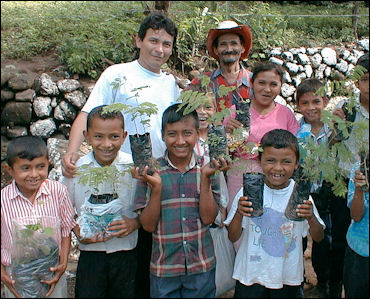
Planting trees in Latin America Suggestions for fighting global warming in the developing world include: 1) using “human-powered” treadle pumps rather than diesel pumps; 2) burning dung rather than firewood in stoves (in some places villagers are encouraged to collect cow paddies and put them in “biogas convertors” to create renewable fuel); 3) using windmills; 4) planting trees; 5) using cleaner, more efficient stoves; and 6) using more energy-efficient light bulbs.
Treadle pumps are worked by people who step on pedals. They are used mostly to bring groundwater and well water to the surface to fill irrigation ditches in fields. NGOs involved in promoting the technology say they reduce poverty, improve agriculture and enable men to stay with their families rather than going off to the cities to work. Climate Care is involved in promoting treadle pumps. It calculates that each one saves 0.66 tons of carbon dioxide a year, a figure arrived at mainly by calculating how greenhouse gases would be used were a diesel pump used.
Climate Care is an NGO involved in promoting clean and low-greenhouse-gas technologies. People who take a long airplane trip or do something else that creates a lot of greenhouse gases give money to Climate Care and the organization takes action to reduce the amount of gases created by planting trees or promoting the use of low-greenhouse-gas technologies in developing countries. Climate care’s “carbon calculator,” for example, calculates that round trip flight from London to Madrid burns 0.68 tons of carbon dioxide and requires a payment of $9.87 to fix. Some critics have accused Climate Care of promising more than it can delivers and “misleading the public, making them believe that offsetting does some good” with claims that its methods save more greenhouse gases than they actually do.
Infrastructure in the Developing World
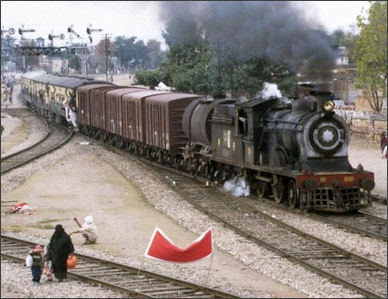
Steam train in Pakistan Cities don't have nearly enough electricity, sewers, water or housing for everyone. Mass transportation systems and sewage treatment plants are often unfinished or behind schedule or not built. When projects are being carried out, like the installation a natural gas heating system to replace polluting coal plants, the city is torn up block by block, causing huge traffic jams and lots of noise.
Improved roads, communications and expansion of electricity and the switch from animals to machines has dramatically changed rural life.
Many villagers build their own dams, schools and roads instead of waiting for government funds. Some times guerilla groups help out with local project to earn brownie points with the people.
Dams in the Developing World
Dams have been built to control flooding, improve transportation, generate electricity and provide water for irrigation and other uses.
The world’s 45,000 large dams catch 14 percent of all precipitation runoff, provide water for up to 40 percent of irrigated land and give 65 countries more than half of their electricity.
Large numbers rural people have lost their homes as a result of hydroelectric dam projects. Some have been evicted from their land and received little or no compensation. Without a means of making a living, many of the displaced people migrate to the cities.
A number of countries have had success with microhydroelectric plants. The systems — set up with support of local people — divert waters from streams and rivers to run turbines with complex dams and catchment areas. Plants produce up to 200 kilowatts, enough to provide electricity for 200 to 500 homes.
Image Sources: Wikimedia Commons
Text Sources: New York Times, Washington Post, Los Angeles Times, Times of London, Yomiuri Shimbun, The Guardian, National Geographic, The New Yorker, Time, Newsweek, Reuters, AP, Lonely Planet Guides, Compton’s Encyclopedia and various books and other publications.
Last updated January 2012
